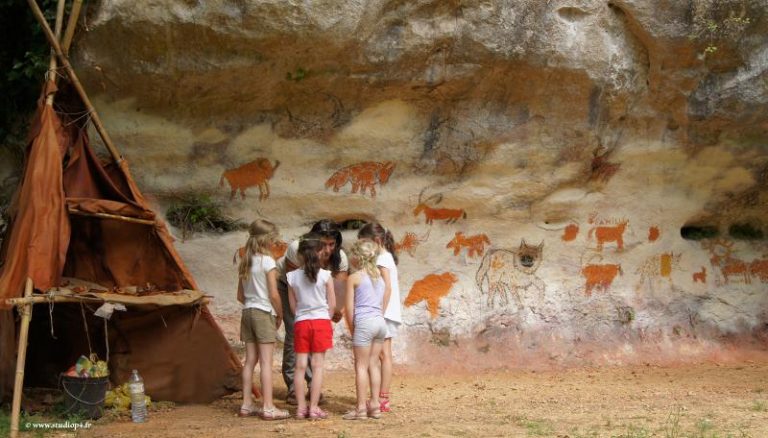Discover all the treasures hidden in dordogne by visiting its Prehistoric sites.
Also take a look at the others things to see in the region.
Discover and live Prehistory with the family at the Castel Merle Site
A few minutes from the Estate, this prehistoric site offers many educational activities.
Quality guided tours and activities that allow you to discover and experience the daily life of prehistoric men.
Located in the heart of the Vézère Valley, between Montignac-Lascaux and Les Eyzies-de-Tayac, this authentic and classified site presents 10 remarkable rock shelters, occupied by the Neanderthal man 85,000 years ago and then by Cro-Magnon man 35,000 years ago. It is one of the highest concentrations of deposits in Europe, reflecting an exceptional continuity of human occupation.
Unmissable visit.
Open from April 06 to September 30, 2020 For more information, visit the site https://www.castel-merle.com
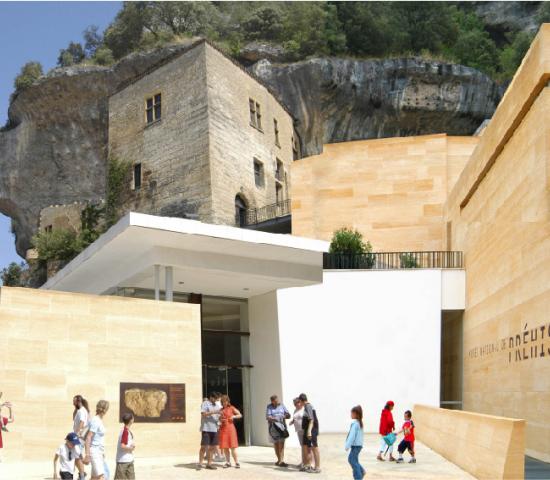
National museum of Prehistory in Les Eyzies
A must-see museum in Périgord and even beyond, overlooking the village, the museum offers several rooms presenting:
– The evolution of the size of flints for 2.5 million years, the main stages of human cultures, the Paleolithic periods.
– A unique and original collection of the first human works of art.
– New acquisitions and everything about quaternary fauna discovered in paleontological sites.
– Anthropology and funeral rites, fauna hunted by Prehistoric Man.
And the extension of the Museum continues with the construction of new buildings.
Thot center / Cromagnon space
This prehistoric initiation center is located on the Thot hill, overlooking the Vézère valley. It includes a museum exhibiting a wide panorama of prehistoric art thanks to modern museography, and a park presenting a fauna that the Cro-Magnon Man rubbed shoulders with and represented, as well as reconstructions of prehistoric camps and scenes from everyday life .
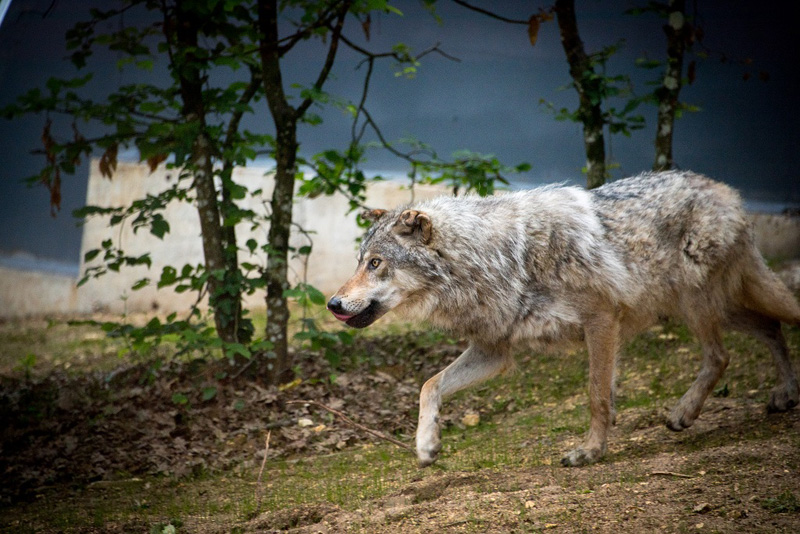
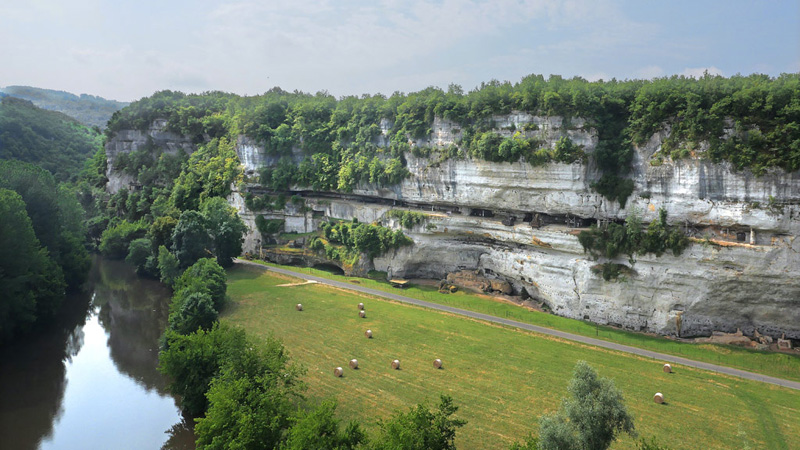
La Roque Saint Christophe, troglodytic city and fort in Peyzac-Le-Moustier
Remarkable for the beauty of its site classified as a “Historic Monument”, La Roque Saint Christophe forms a setting of rare and wild beauty. This cliff dominates the Vézère Valley over 900 meters and over 5 floors. Its hundred rock shelters were the cradle of many civilizations from Prehistory to the Middle Ages. The prodigious entablatures could shelter up to 1000 men. There, you will discover the habitat of our ancestors as well as traces of their tools, their industry, their art and their worship. In this immense natural fortress, a remarkable troglodyte fort and its city served as ramparts against the Normans, and made this place one of the wonders of the Vézère Valley.
La Madeleine Troglodytic Village in Tursac
The Madeleine Grand site is an invitation to go back in time … This exceptional natural site, among the best preserved in the Vézère Valley, has attracted people from Prehistory to the present day. At the foot of the cliff, 17,000 years ago, semi-nomadic hunter-gatherers settled there. The Prehistoric site has given its name to this prehistoric civilization: The Magdalenian. Halfway up the cliff, you will discover a medieval troglodyte village. It has been inhabited since the High Middle Ages until the end of the 19th century. Among the buildings dug in the rock, a remarkable Gothic chapel from the 15th century is hung on the cliff. On the upper floor, on the limestone plateau, are the remains of the Petit-Marzac castle, built in the 13th century. Here, the eye of the beholder will humbly observe the know-how and ingenuity of these rural “troglodytes” who have taken advantage of their natural environment (stone, wood, water and agricultural land) to build their refuge. In these times when we wonder about the use of our resources, coming to be inspired by what was done at the Madeleine can serve as an example for our future.
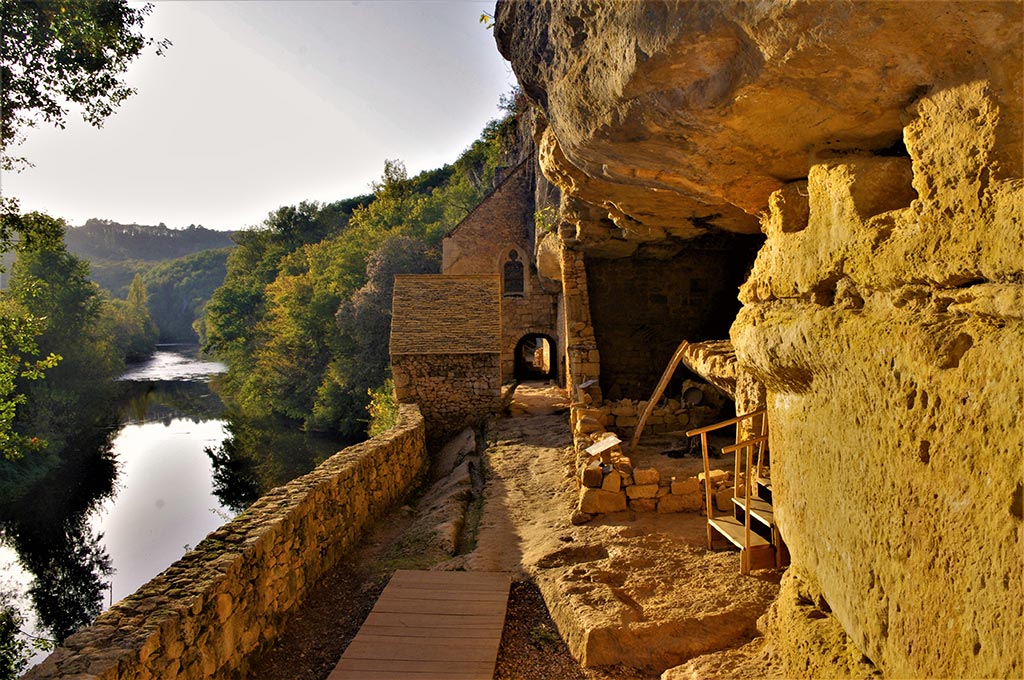
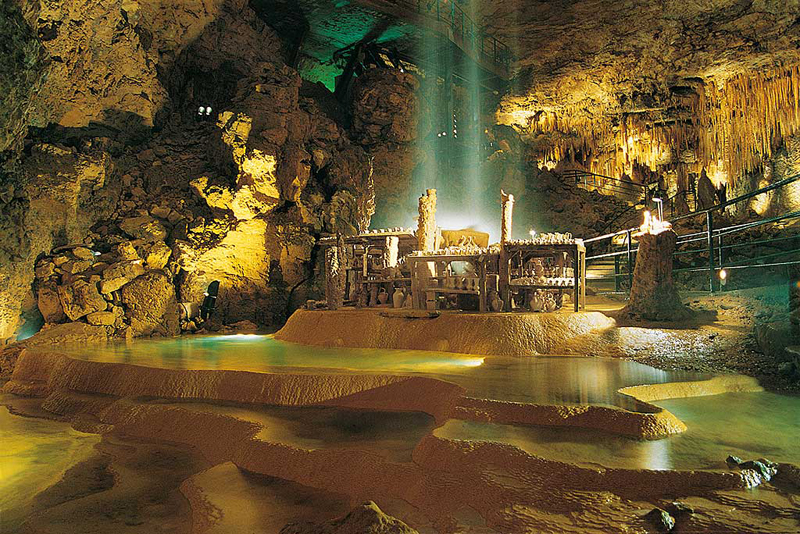
Proumeyssac abyss in Audrix
Protected by one of the magnificent hillsides of the Vézère Valley; the Gouffre de Proumeyssac is the largest cavity in Périgord (50m). The density and the variety of crystallizations which decorate the walls of this immense underground vault which one embraces with a single glance, offer a real geological interest. With a new highlight created for the 3rd millennium and thanks to significant improvements, the Gouffre de Proumeyssac unveils new charms. The new visit, based on new advanced technology, meets the multiple expectations of the public.
Troglodytic Natural Park "Le Conquil" - Dinosaur Park
in Saint-Léon-Sur-Vézère
in Saint-Léon-Sur-Vézère
10 minutes from Lascaux, the troglodyte shelters of Conquil offer you a day of discovery in an exceptional site.
Free visit of the shelters with a complete booklet. Prehistoric leisure park.
And every day, flint pruning, archery, thruster shooting. Hunting trail possible by appointment. Country bar, picnic areas, shop.

La Dordogne, une région riche en histoire et en découvertes !
La Dordogne se décline en quatre Périgords. Comme autant de saisons, ils vous offrent une grande diversité de paysages où il fait bon se promener tout au long de l’année.
Le Périgord Blanc s’étale le long de la Vallée de l’Isle. C’est un pays blanc car calcaire. Cette roche se retrouve dans les constructions et notamment la cathédrale Byzantine de Périgueux, sa capitale, qui fut une cité Romaine importante dont les vestiges sont toujours visibles.
Le Périgord Vert s’étend au Nord du département. Le parc Naturel Régional Périgord Limousin est un écrin de verdure parcouru par de nombreux ruisseaux le long desquels de nombreuses petites villes pleines de charme vous accueilleront.
Le Périgord Pourpre est au Sud, sur les côteaux de la vallée de la Dordogne. Il est regroupé autour de Bergerac et de ce vignoble réputé. Les Bastides, villages fortifiés sont nombreux et pleins de ce caractère qui fait la renommée d’un célèbre personnage : Cyrano de Bergerac.
Le Périgord Noir, quant à lui recèle un patrimoine exceptionnel avec les vallées de la Dordogne, de la Vézère, les Eyzies, capitale du monde de la Préhistoire, Sarlat, Ville d’art et d’histoire, Lascaux et tous les sites classés au patrimoine mondial de l’UNESCO.



